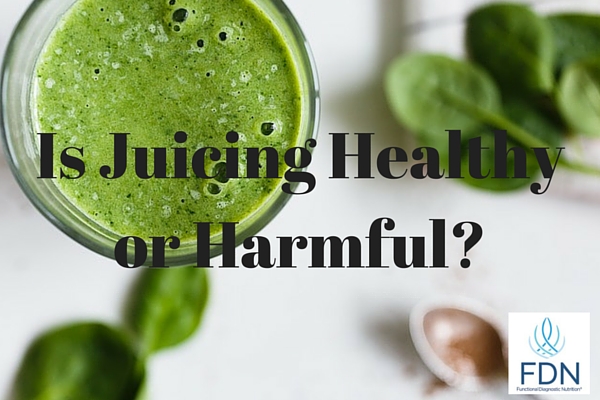Most people would agree that eating vegetables is important to a healthy diet. A growing body of research confirms diets rich in fresh, organic, plant based foods, when combined with the proper ratio of proteins and fats, play an essential role in good health. But what about drinking your vegetables? It’s a quick and easy way to get in lots of nutrients. On the surface, juicing seems like a perfect way to incorporate more of what we need into our diets. But, is juicing healthy or harmful?
Here are some ways that juicing can be less than healthy.
It Can Cause Sugar Spikes
Most juices are delicious. That doesn’t sound like a problem at all, does it? Well, like any good FDN functional health coach would teach you, you must consider the source. What is making that juice so tasty? SUGAR. Fruit is sweet because it has a lot sugar. Typically when you juice you will be consuming more fruit and fruit based sugar than you would if you were eating a normal serving.
Did you know that it takes about 4 medium oranges to make one 8 ounce glass of orange juice? It would be rare to see someone sit down and eat 4 oranges in one sitting, but no one thinks twice about throwing back that amount or more in the form of juice. So the amount of sugar in juice can add up quickly.
The average juice drink has between 60-100 grams of sugar.
This is about the same as 2-3 cans of Coca Cola!
While eating whole fruit is a healthier choice than a soft drink, drinking juice really isn’t. Juicing strips away fiber and concentrates the sugars from several servings of fruits and vegetables into a single drinkable serving. The digestion of liquids occurs significantly quicker than the digestion of whole foods. This means that when you drink your juice, all of that concentrated sugar spikes your blood sugar levels much faster than fruit eaten in its solid form.
Fructose is the main sugar found in fruit. Fructose metabolism produces fat molecules as byproducts. The more fructose your liver has to metabolize, the more fat builds up. A study published in the “Journal of Clinical Investigation” showed that excess fructose intake causes non-alcoholic fatty liver disease. It can also increase blood lipids and insulin resistance (which can lead to Type II Diabetes). Furthermore, high sugar intake is commonly associated with the onset and proliferation of small intestinal bacterial overgrowth (SIBO) and fungal overgrowth like candida.
Leaving the fiber behind
The juicing process extracts and discards fiber and nutrient dense skins from the fruits and vegetables. This is a problem for several reasons. From a nutrient standpoint, plant-based foods take in energy from the sun, and many of the nutrients are found in their colorful skins. Unfortunately, these never make it to your glass. Fiber, which plays an important role in regulating blood sugar, is missing from juice but is present in the whole food. Mother Nature put it there for a reason. As mentioned earlier, spikes in blood sugar can negatively impact your health. Fiber also helps with satiation, so you feel full and satisfied until your next meal. Without it, juice drinkers may find themselves looking for a snack shortly after they have consumed their juice drink. Additionally, fiber plays an important role in elimination, gastrointestinal health and keeping cholesterol levels in check.
Skipping steps in digestion
Juicing bypasses the first step in the digestion process. Digestion starts in the mouth with two important processes: the mechanical breakdown of food through chewing and the chemical breakdown through saturation with saliva. To be fair, a juicer does a great job on the mechanical task, but falls short on chemical digestion. When consumed, juices spend little to no time in the mouth, so the chemical process is bypassed completely. As a result, bloating and gas can occur, along with an increased risk of undigested food particles fermenting in the gut.
Carbohydrate Cocktails
Juices contain a great source of carbohydrates, but lack the other key macronutrients necessary to balance out the meal.
It is important to note that while fruit and vegetable juices can be packed with a wide variety of nutrients, they tend to have very little protein and fat. These drinks should be used in addition to or to supplement your regular meals, not to replace it. Liquid juicing diets are not sufficient for long-term health.
A growing body of research supports the fact that optimum health can be more easily achieved when people consume the right ratios of macronutrients for their body’s unique genetic requirements. Each person will have slightly different needs, but all will require at least some fat, proteins AND carbohydrates at each meal.
FDN says “You can have your juice and drink it, too”
FDN recognizes that juicing can be a valuable and efficient tool when it comes to increasing the amount of whole plant foods in the diet. When done properly, juicing can be a great way to incorporate a greater variety of raw, whole foods into the diet with minimal prep work, clean up and zero cooking skills.
Here are five fantastic FDN fixes to ensure each sip is bringing you closer to optimum health.
A Blender Is Better
Try swapping your juicer for a masticating blender, like a Vitamix or Nutribullet. These high-powered machines will pulverize and extract all of the nutrients, blending them into a smooth drinkable tonic, skins, seeds and fiber included. Juicers, on the other hand, do not utilize skins or seeds and separate the fiber out of the drink. If you have a juicer and are not willing to make the switch, don’t forget the fiber. You can use the fiber-filled juice pulp that is left behind by blending it back into your drink or using it in recipes (you can find hundreds of recipes on the internet for soups to crackers to meatballs).
But be aware: fiber isn´t for everyone. It can put extra stress on an overworked digestive system and serve as hives for bugs if the intestine has kinks in it. So, the trick is to know your body and your own needs.
Go Green
Look for juice recipes that utilize a wide variety of green, non-starchy vegetables to keep the sugar content of your drink down. Adding too many fruits and sweet veggies like carrots and beets can turn your healthy drink into a sugar-laden dessert, spiking your blood sugar and leaving you feeling fatigued and hungry a short time later. Swap out apples, oranges and bananas for lemons and limes. Lemons and limes are virtually free of fructose and do a great job to equalize the bitter flavor of many green vegetables. Cucumbers and celery can also add a hint of sweetness, and spices like fresh ginger and cinnamon can create a palette-pleasing nutritional boost.
Savor the Flavor
Instead of gulping down your nutrient-enriched elixir, take some time to “chew” or swirl it around in your mouth. Allow you taste buds to experience the fresh flavors, and more importantly, give your saliva a chance to mix with the nutrients. Saliva contains an important digestive enzyme called Ptyalin, which helps to break down food through chemical reactions. There is a significant link between smaller particle size and increased nutrient uptake. The better you break your food down, the easier your cells can utilize it.
Balance Your Beverage
As we mentioned earlier, vegetable juice is not a complete meal and certainly does not meet macro-nutrient requirements for any metabolic type, as each person requires a specific amount of protein, fats and carbohydrate in each meal in order to keep their metabolic machine running smoothly.
Juicing recipes, just like meals, must be carefully customized to fit the needs of an individual’s unique metabolic type. Some may tolerate larger portions, while others may need only a small amount of juice. Everyone will need to balance out their juices by adding some healthy fats and proteins, keeping in mind the type and amounts recommended for their specific metabolic type. Some choices might include: raw cream, grass fed butter, raw egg yolks, avocado, coconut oil, and high quality protein powders.
Become fluent in body language
One of wonderful aspects of juicing is that people often find themselves consuming a wider variety of vegetables. While this is wonderful for nutrition, in some cases, it can also leave you feeling less than perfect.
Start by juicing the same vegetables that you enjoy eating whole. Listen to your body, and add new ingredients one at a time. This will help you to easily identify any problem-causing foods that you might be sensitive to or intolerant of. If you suspect a food is causing trouble, remove it. A FDN functional health coach can recommend specific functional laboratory testing to uncover any foods you are reactive to and that should be removed from your diet. Running the test saves you from the uncomfortable task of trial and error and also uncovers any foods that might be causing inflammation but are not yet producing symptoms, or at least not symptoms that you are connecting to food. Food intolerance and sensitivities can be tricky to pinpoint as sometimes the reaction does not surface right away, but instead, after the next meal or the even next day. Most people are surprised to find that some of their favorite foods are sometimes ones that can also be damaging. Remember, even healthy foods can cause inflammation in some people. To reiterate Lucretius’ notion: one man’s food is another man’s poison.
There you have it. Done right, juicing for your body can be a great tool for health success – raise your glass!







